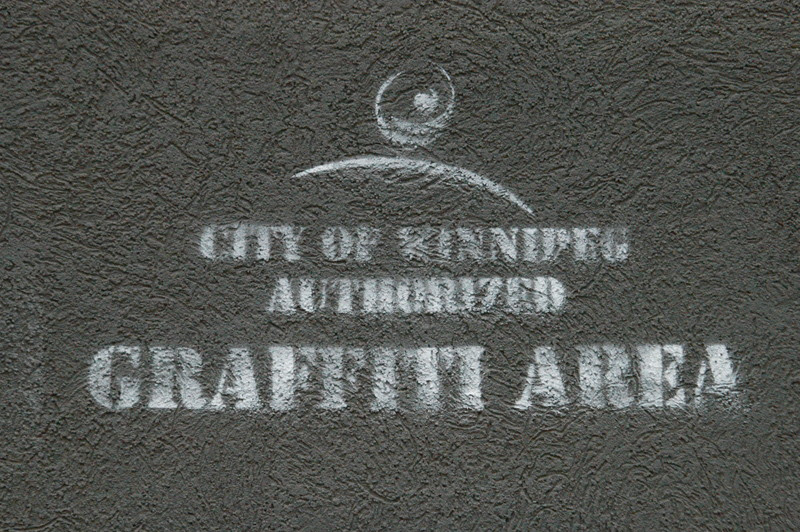Free graffiti walls elaborate prank, city says
Designated walls in other cities don’t prevent spread of graffiti
If you happen to see a City of Winnipeg Authorized Graffiti Area image stenciled with spray paint anywhere in the city, don’t believe it.
Markers, including stenciled words and a replica City of Winnipeg logo, have been spotted on garage doors and strip malls in the West End of the city as well as in the Exchange District. The icons are the work of guerrilla graffiti painters, according to the City of Winnipeg.
“This is not an initiative that we are encouraging at all. It sounds like someone is just trying to spur proliferation of graffiti,” said supervisor of public service operations Bob Okabe.
The City of Winnipeg offers extensive graffiti prevention and removal services to individual residents as well as communities, including telephone lines to report graffiti in process.
Designating specific spots for aerosol art is a decision that could encourage the practice beyond certain walls, according to Okabe. He cites the example of a mural on one side of the former Osborne Village Freehouse, now known as the Academy. In the 1990s when the owners allowed artists to paint on the backside of the establishment, graffiti spread further down the back lane and on to non-consenting businesses.
For areas like the historic Exchange District, graffiti and its removal has become an increasing problem.
“The vandal thinks it’s just another building, but because of the historic masonry and some of the terracotta work, it poses all sorts of challenges in cleaning it,” Okabe noted.
Preservation of the structures and character in the 30 blocks that encompass the National Historic Site is of great concern to the Exchange District Business Improvement Zone (BIZ).
“I would be absolutely floored if the city would approve something like [designated areas for graffiti],” said director of operations Brian Timmerman. “This is a historic area; we don’t want any graffiti.”
The district has seen reduced instances of tagging over the past five years, which Timmerman attributes to its 24- to 48-hour removal policy. Even with fewer and less frequent sprees of up to 10 buildings at a time, the BIZ sends a staff member out weekly to carefully remove spray paint in order to preserve original facades of the businesses and residences.
Designating specific areas has never been an option for the Exchange after seeing their ineffectiveness in other cities like Montreal and Vancouver, said Timmerman.
“The idea was that if you give them a wall to do their tags, then they’ll respect the other buildings, and it’s shown not to work [in reducing instances of graffiti].”
While the concept of legal walls may not reduce the amount of graffiti, it will benefit artists’ skills.
“If people don’t have an outlet, they’re going to put it somewhere,” said Pat Lazo, artistic director of Winnipeg’s Graffiti Gallery. “If there’s a legal outlet, people can express themselves and take their art to another level.”
Lazo, who works at the non-profit community youth art centre, stresses that while occasions exist to paint murals for businesses and community projects, not all artists are afforded the same chances to hone their talents.
“Especially with legal walls, artists could take a few hours to work on something rather than having to finish something in an hour illegally,” Lazo said. “If we had those opportunities, then the level of street art that you see would greatly improve.”







